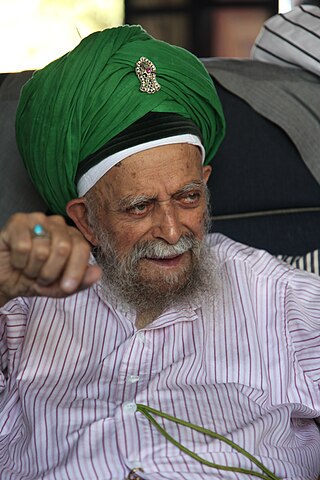
Sufism is a mystic body of religious practice found within Islam which is characterized by a focus on Islamic purification, spirituality, ritualism, and asceticism.

A tariqa is a religious order of Sufism, or specifically a concept for the mystical teaching and spiritual practices of such an order with the aim of seeking haqiqa, which translates as "ultimate truth".

The Naqshbandi order is a Sufi order of Sunni Islam named after Baha al-Din Naqshband. They trace their silsila to Prophet Muhammad through the first caliph Abu Bakr by the way of Ja'far al-Sadiq. The Naqshbandi Sufi order is most distinguished from other Sunni Sufi orders by the high level of importance they assign to the Sharia, highlighted by major Naqshbandi scholars such as Ahmad Sirhindi and Shah Waliullah Dehlawi.

Hisham Kabbani was a Lebanese-American Sunni Sufi Muslim scholar belonging to the Naqshbandi Haqqani Sufi order. Kabbani has counseled and advised Muslim leaders to build community resilience against violent extremism. In 2012, the Royal Islamic Strategic Studies Centre named him on The 500 Most Influential Muslims.

The Qadiriyya or the Qadiri order is a Sunni Sufi order (Tariqa) founded by Abdul Qadir Gilani, who was a Hanbali scholar from Gilan, Iran.

Sufism is the mystical branch of Islam in which Muslims seek divine love and truth through direct personal experience of God. This mystic tradition within Islam developed in several stages of growth, emerging first in the form of early asceticism, based on the teachings of Hasan al-Basri, before entering the second stage of more classical mysticism of divine love, as promoted by al-Ghazali and Attar of Nishapur, and finally emerging in the institutionalized form of today's network of fraternal Sufi orders, based on Sufis such as Rumi and Yunus Emre. At its core, however, Sufism remains an individual mystic experience, and a Sufi can be characterized as one who seeks the annihilation of the ego in God.

Abdullah al-Faiz ad-Daghistani, was the 39th Shaykh in the Naqshbandi Haqqani Silsila.

Mawlana Khâlid Sharazuri also known as Khâlid-i Baghdâdî and Mawlana Khalid was a Kurdish Sufi, and poet by the name of Shaykh Diya al-Dīn Khalid al-Shahrazuri, the founder of a branch of the Naqshbandi Sufi order - called Khalidi after him - that has had a profound impact not only on his native Kurdish lands but also on many other regions of the western Islamic world. His writings are among the earliest examples of prose and poetry in Central Kurdish.
Islam in Cyprus is the island's second-largest religion after Christianity, and is also the predominant faith of the Turkish Cypriot community which resides in Northern Cyprus. Before the Turkish invasion of Cyprus in 1974, the Turkish Cypriot community made up 18% of the island's population and lived throughout the island. Today, most of the estimated 264,172 Muslims are based in the north of the island.
Ahmed Dede is an Islamic sheikh, and a follower of the Sufi order of Islam, who helps spread Sufism and the art of Sufi Whirling in the United Kingdom. He has appeared on British television several times.
The First and Second International Islamic Unity Conference were conferences organized by followers of the Naqshbandi Haqqani Sufi Order in Los Angeles (1996) and Washington DC (1998). Sufi and Sufi-friendly Muslim representatives, Islamic scholars and politicians were invited to the conferences. The conferences exemplified the Haqqani-Naqshbandis' ambitions to establish itself as a major player within the American Muslim scene. The conference was supported in part by members of royalty, Muslim political and religious leaders from across the world.

The Uwaisī silsila or tariqa (pathway) is a form of spiritual transmission in the vocabulary of Sufism, named after Owais al-Qarani. It refers to the transmission of spiritual knowledge between two individuals without the need for direct interaction between them.

The Ba'Alawi tariqa, also known as the Tariqa Ba Alawiyya is a Sufi order centered in Hadhramawt, Yemen, but now spread across the Indian Ocean rim along with the Hadhrami diaspora. The order is closely tied to the Ba'Alawi sadah family.
Sayyad Laal Shah Hamdani was an Islamic scholar and prominent Sufi shaykh of Naqshbandi tariqah in South Asia.

Shaykh Muhammad Nazim Adil Al-Qubrusi Al-Haqqani, commonly known as Shaykh Nazim, was a Turkish Cypriot Sunni Muslim imam and one of the most influential members of the Haqqani stream of the Naqshbandi order (tariqa) of Sunni Islam.
The Naqshbandi-Haqqani Golden Chain is the chain of succession of Sufi masters in the Naqshbandi-Haqqani Sufi Order.
Aydoğan Fuat, formally referred to as Shaykh Abdul Kerim al-Qubrusi, was an American Sufi Sheikh of Turkish Cypriot origin and former representative of the Naqshbandi-Haqqani Order in the United States, under the leader Nazim Al-Haqqani.
Shaykh Mehmet 'Ádil was born on 29 March 1957 in Damascus, Shām. He is the successor and oldest son of Sultan-ul 'Awliyá Sheikh Muhammad Nazim 'Ádil al-Haqqání and Hajjah Amina 'Ádil Sultan Hánim, and the current spiritual leader (grandshaykh) of the Haqqani branch of the Naqshbandi Sufi order.

Nāṣir ad-Dīn ʿUbaydullāh ibn Maḥmūd ibn Shihāb ad-Dīn more popularly known as Khwaja Ahrar was a member of the Golden Chain of the Naqshbandi Sufi spiritual order of Central Asia. He was born in Samarkand, a city in Central Asia, to a Muslim family. He was born to Khwaja Mehmood Shashi bin Khwaja Shihabuddin. His forefathers had migrated from Baghdad, and his lineage was connected to Abu Bakr Siddique from his paternal side and Umar Farooq from the maternal side. Khwaja Ahrar was deeply involved in the social, political and economics activities of Transoxania. He was born into a relatively poor yet highly spiritual family and, at the age of maturity, he was probably the richest person in the kingdom. He was a close associate of all the leading dervishes of the time. Maulana Abdur Rahman Jami was a disciple of his. He learned and practiced the secrets of spirituality under his father and later under Khwaja Yaqub Charkhi.

Sufism, or Taṣawwuf, variously defined as "Islamic mysticism", or, the inward dimension of Islam, is the primary manifestation of mystical practice in Islam. Jordan is considered by many Sufis to be "a spiritual center and a fertile environment for Sufism," at least in part due to the fact that many of the narratives from the Qur’an take place within its modern borders. Many of the Sufis in Jordan today belong to one of six main orders or tariqa: Qadiri, Naqshbandi, Rifa'i, Shadhili, Khalwati, and Tijani. The oral history of Sufi practice in northern Jordan goes back at least as far as the 13th century, and was "documented as early as the 16th century in Ottoman tax registers." Sufism in modern-day Jordan remained prominent through the mid-20th century.
Up until the era of independence, Sufi orders and popular forms of Sufi religiosity dominated the religious scene, with other Islamic movements and groups beginning to emerge only later as branches of other groups already established outside the boundaries of the Hashemite Kingdom.






